Ziyu Zhao
Noise Projection: Closing the Prompt-Agnostic Gap Behind Text-to-Image Misalignment in Diffusion Models
Oct 16, 2025Abstract:In text-to-image generation, different initial noises induce distinct denoising paths with a pretrained Stable Diffusion (SD) model. While this pattern could output diverse images, some of them may fail to align well with the prompt. Existing methods alleviate this issue either by altering the denoising dynamics or by drawing multiple noises and conducting post-selection. In this paper, we attribute the misalignment to a training-inference mismatch: during training, prompt-conditioned noises lie in a prompt-specific subset of the latent space, whereas at inference the noise is drawn from a prompt-agnostic Gaussian prior. To close this gap, we propose a noise projector that applies text-conditioned refinement to the initial noise before denoising. Conditioned on the prompt embedding, it maps the noise to a prompt-aware counterpart that better matches the distribution observed during SD training, without modifying the SD model. Our framework consists of these steps: we first sample some noises and obtain token-level feedback for their corresponding images from a vision-language model (VLM), then distill these signals into a reward model, and finally optimize the noise projector via a quasi-direct preference optimization. Our design has two benefits: (i) it requires no reference images or handcrafted priors, and (ii) it incurs small inference cost, replacing multi-sample selection with a single forward pass. Extensive experiments further show that our prompt-aware noise projection improves text-image alignment across diverse prompts.
FedEve: On Bridging the Client Drift and Period Drift for Cross-device Federated Learning
Aug 20, 2025Abstract:Federated learning (FL) is a machine learning paradigm that allows multiple clients to collaboratively train a shared model without exposing their private data. Data heterogeneity is a fundamental challenge in FL, which can result in poor convergence and performance degradation. Client drift has been recognized as one of the factors contributing to this issue resulting from the multiple local updates in FedAvg. However, in cross-device FL, a different form of drift arises due to the partial client participation, but it has not been studied well. This drift, we referred as period drift, occurs as participating clients at each communication round may exhibit distinct data distribution that deviates from that of all clients. It could be more harmful than client drift since the optimization objective shifts with every round. In this paper, we investigate the interaction between period drift and client drift, finding that period drift can have a particularly detrimental effect on cross-device FL as the degree of data heterogeneity increases. To tackle these issues, we propose a predict-observe framework and present an instantiated method, FedEve, where these two types of drift can compensate each other to mitigate their overall impact. We provide theoretical evidence that our approach can reduce the variance of model updates. Extensive experiments demonstrate that our method outperforms alternatives on non-iid data in cross-device settings.
OS Agents: A Survey on MLLM-based Agents for General Computing Devices Use
Aug 06, 2025Abstract:The dream to create AI assistants as capable and versatile as the fictional J.A.R.V.I.S from Iron Man has long captivated imaginations. With the evolution of (multi-modal) large language models ((M)LLMs), this dream is closer to reality, as (M)LLM-based Agents using computing devices (e.g., computers and mobile phones) by operating within the environments and interfaces (e.g., Graphical User Interface (GUI)) provided by operating systems (OS) to automate tasks have significantly advanced. This paper presents a comprehensive survey of these advanced agents, designated as OS Agents. We begin by elucidating the fundamentals of OS Agents, exploring their key components including the environment, observation space, and action space, and outlining essential capabilities such as understanding, planning, and grounding. We then examine methodologies for constructing OS Agents, focusing on domain-specific foundation models and agent frameworks. A detailed review of evaluation protocols and benchmarks highlights how OS Agents are assessed across diverse tasks. Finally, we discuss current challenges and identify promising directions for future research, including safety and privacy, personalization and self-evolution. This survey aims to consolidate the state of OS Agents research, providing insights to guide both academic inquiry and industrial development. An open-source GitHub repository is maintained as a dynamic resource to foster further innovation in this field. We present a 9-page version of our work, accepted by ACL 2025, to provide a concise overview to the domain.
TRACE: Grounding Time Series in Context for Multimodal Embedding and Retrieval
Jun 10, 2025Abstract:The ubiquity of dynamic data in domains such as weather, healthcare, and energy underscores a growing need for effective interpretation and retrieval of time-series data. These data are inherently tied to domain-specific contexts, such as clinical notes or weather narratives, making cross-modal retrieval essential not only for downstream tasks but also for developing robust time-series foundation models by retrieval-augmented generation (RAG). Despite the increasing demand, time-series retrieval remains largely underexplored. Existing methods often lack semantic grounding, struggle to align heterogeneous modalities, and have limited capacity for handling multi-channel signals. To address this gap, we propose TRACE, a generic multimodal retriever that grounds time-series embeddings in aligned textual context. TRACE enables fine-grained channel-level alignment and employs hard negative mining to facilitate semantically meaningful retrieval. It supports flexible cross-modal retrieval modes, including Text-to-Timeseries and Timeseries-to-Text, effectively linking linguistic descriptions with complex temporal patterns. By retrieving semantically relevant pairs, TRACE enriches downstream models with informative context, leading to improved predictive accuracy and interpretability. Beyond a static retrieval engine, TRACE also serves as a powerful standalone encoder, with lightweight task-specific tuning that refines context-aware representations while maintaining strong cross-modal alignment. These representations achieve state-of-the-art performance on downstream forecasting and classification tasks. Extensive experiments across multiple domains highlight its dual utility, as both an effective encoder for downstream applications and a general-purpose retriever to enhance time-series models.
DPSeg: Dual-Prompt Cost Volume Learning for Open-Vocabulary Semantic Segmentation
May 16, 2025Abstract:Open-vocabulary semantic segmentation aims to segment images into distinct semantic regions for both seen and unseen categories at the pixel level. Current methods utilize text embeddings from pre-trained vision-language models like CLIP but struggle with the inherent domain gap between image and text embeddings, even after extensive alignment during training. Additionally, relying solely on deep text-aligned features limits shallow-level feature guidance, which is crucial for detecting small objects and fine details, ultimately reducing segmentation accuracy. To address these limitations, we propose a dual prompting framework, DPSeg, for this task. Our approach combines dual-prompt cost volume generation, a cost volume-guided decoder, and a semantic-guided prompt refinement strategy that leverages our dual prompting scheme to mitigate alignment issues in visual prompt generation. By incorporating visual embeddings from a visual prompt encoder, our approach reduces the domain gap between text and image embeddings while providing multi-level guidance through shallow features. Extensive experiments demonstrate that our method significantly outperforms existing state-of-the-art approaches on multiple public datasets.
Extracting Interpretable Logic Rules from Graph Neural Networks
Mar 25, 2025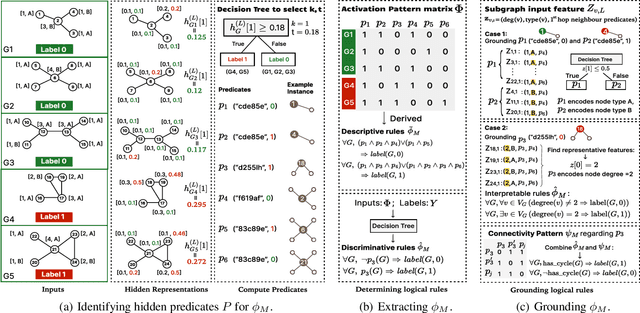


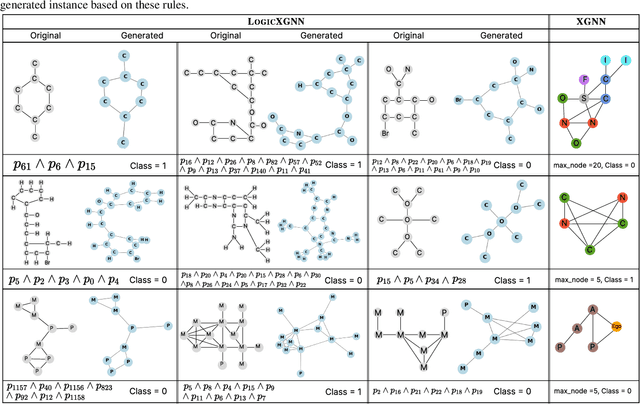
Abstract:Graph neural networks (GNNs) operate over both input feature spaces and combinatorial graph structures, making it challenging to understand the rationale behind their predictions. As GNNs gain widespread popularity and demonstrate success across various domains, such as drug discovery, studying their interpretability has become a critical task. To address this, many explainability methods have been proposed, with recent efforts shifting from instance-specific explanations to global concept-based explainability. However, these approaches face several limitations, such as relying on predefined concepts and explaining only a limited set of patterns. To address this, we propose a novel framework, LOGICXGNN, for extracting interpretable logic rules from GNNs. LOGICXGNN is model-agnostic, efficient, and data-driven, eliminating the need for predefined concepts. More importantly, it can serve as a rule-based classifier and even outperform the original neural models. Its interpretability facilitates knowledge discovery, as demonstrated by its ability to extract detailed and accurate chemistry knowledge that is often overlooked by existing methods. Another key advantage of LOGICXGNN is its ability to generate new graph instances in a controlled and transparent manner, offering significant potential for applications such as drug design. We empirically demonstrate these merits through experiments on real-world datasets such as MUTAG and BBBP.
MTBench: A Multimodal Time Series Benchmark for Temporal Reasoning and Question Answering
Mar 21, 2025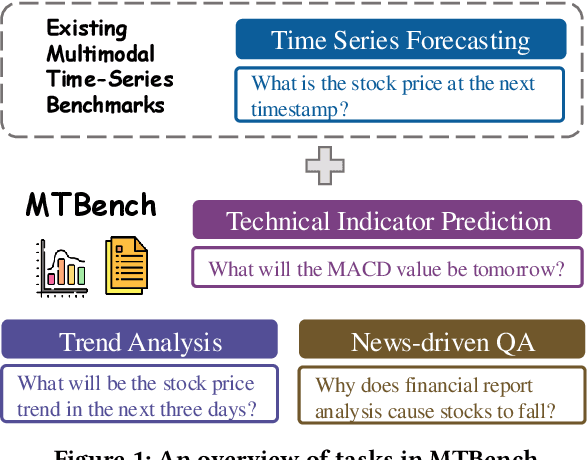

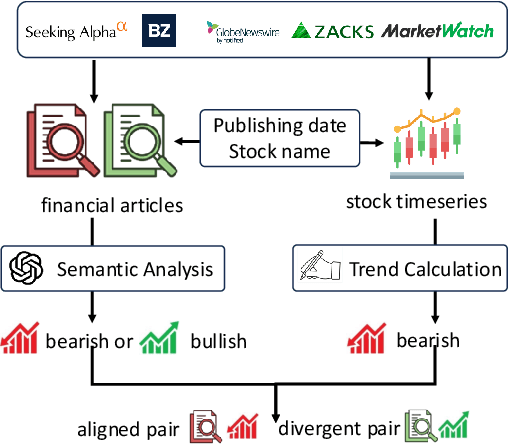

Abstract:Understanding the relationship between textual news and time-series evolution is a critical yet under-explored challenge in applied data science. While multimodal learning has gained traction, existing multimodal time-series datasets fall short in evaluating cross-modal reasoning and complex question answering, which are essential for capturing complex interactions between narrative information and temporal patterns. To bridge this gap, we introduce Multimodal Time Series Benchmark (MTBench), a large-scale benchmark designed to evaluate large language models (LLMs) on time series and text understanding across financial and weather domains. MTbench comprises paired time series and textual data, including financial news with corresponding stock price movements and weather reports aligned with historical temperature records. Unlike existing benchmarks that focus on isolated modalities, MTbench provides a comprehensive testbed for models to jointly reason over structured numerical trends and unstructured textual narratives. The richness of MTbench enables formulation of diverse tasks that require a deep understanding of both text and time-series data, including time-series forecasting, semantic and technical trend analysis, and news-driven question answering (QA). These tasks target the model's ability to capture temporal dependencies, extract key insights from textual context, and integrate cross-modal information. We evaluate state-of-the-art LLMs on MTbench, analyzing their effectiveness in modeling the complex relationships between news narratives and temporal patterns. Our findings reveal significant challenges in current models, including difficulties in capturing long-term dependencies, interpreting causality in financial and weather trends, and effectively fusing multimodal information.
Learning Interpretable Logic Rules from Deep Vision Models
Mar 13, 2025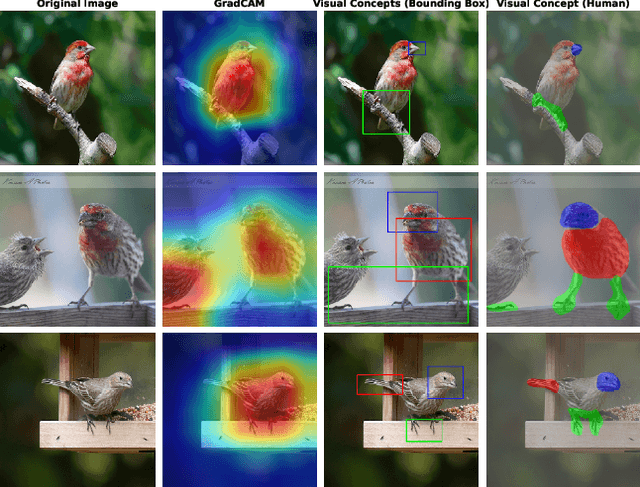

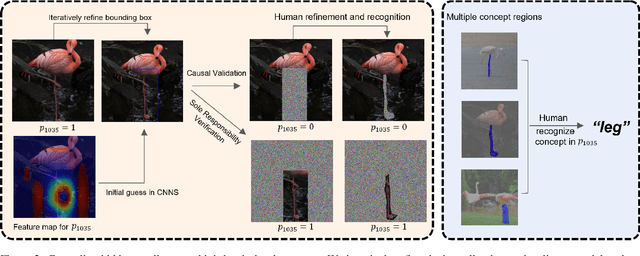

Abstract:We propose a general framework called VisionLogic to extract interpretable logic rules from deep vision models, with a focus on image classification tasks. Given any deep vision model that uses a fully connected layer as the output head, VisionLogic transforms neurons in the last layer into predicates and grounds them into vision concepts using causal validation. In this way, VisionLogic can provide local explanations for single images and global explanations for specific classes in the form of logic rules. Compared to existing interpretable visualization tools such as saliency maps, VisionLogic addresses several key challenges, including the lack of causal explanations, overconfidence in visualizations, and ambiguity in interpretation. VisionLogic also facilitates the study of visual concepts encoded by predicates, particularly how they behave under perturbation -- an area that remains underexplored in the field of hidden semantics. Apart from providing better visual explanations and insights into the visual concepts learned by the model, we show that VisionLogic retains most of the neural network's discriminative power in an interpretable and transparent manner. We envision it as a bridge between complex model behavior and human-understandable explanations, providing trustworthy and actionable insights for real-world applications.
Each Rank Could be an Expert: Single-Ranked Mixture of Experts LoRA for Multi-Task Learning
Jan 25, 2025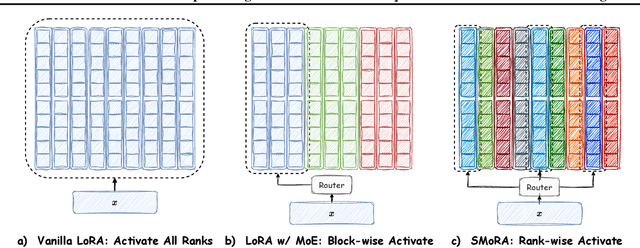
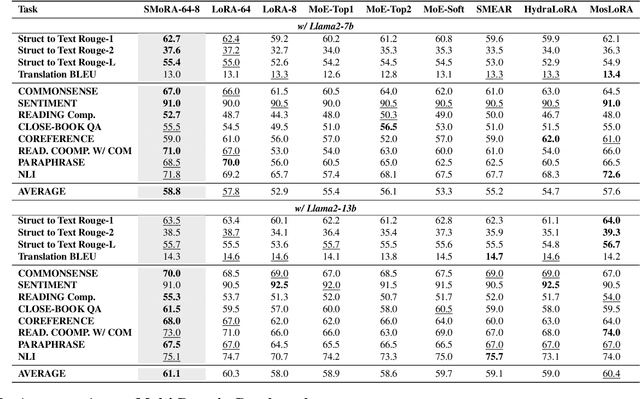
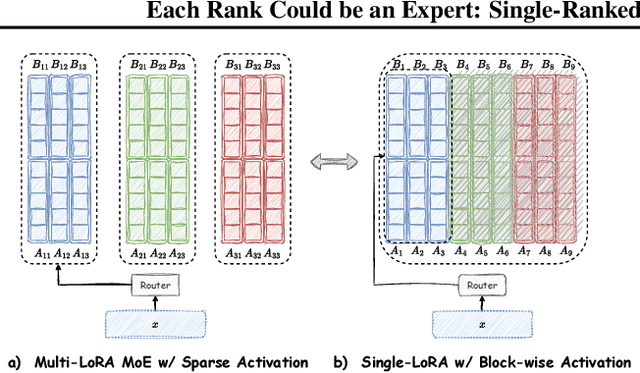
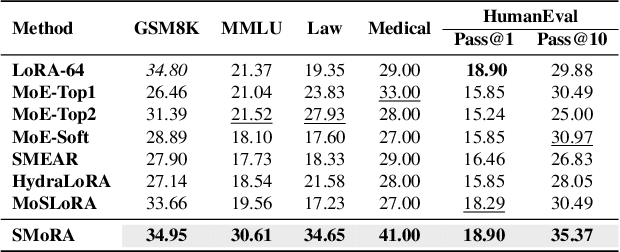
Abstract:Low-Rank Adaptation (LoRA) is widely used for adapting large language models (LLMs) to specific domains due to its efficiency and modularity. Meanwhile, vanilla LoRA struggles with task conflicts in multi-task scenarios. Recent works adopt Mixture of Experts (MoE) by treating each LoRA module as an expert, thereby mitigating task interference through multiple specialized LoRA modules. While effective, these methods often isolate knowledge within individual tasks, failing to fully exploit the shared knowledge across related tasks. In this paper, we establish a connection between single LoRA and multi-LoRA MoE, integrating them into a unified framework. We demonstrate that the dynamic routing of multiple LoRAs is functionally equivalent to rank partitioning and block-level activation within a single LoRA. We further empirically demonstrate that finer-grained LoRA partitioning, within the same total and activated parameter constraints, leads to better performance gains across heterogeneous tasks. Building on these findings, we propose Single-ranked Mixture of Experts LoRA (\textbf{SMoRA}), which embeds MoE into LoRA by \textit{treating each rank as an independent expert}. With a \textit{dynamic rank-wise activation} mechanism, SMoRA promotes finer-grained knowledge sharing while mitigating task conflicts. Experiments demonstrate that SMoRA activates fewer parameters yet achieves better performance in multi-task scenarios.
Decoding Interpretable Logic Rules from Neural Networks
Jan 14, 2025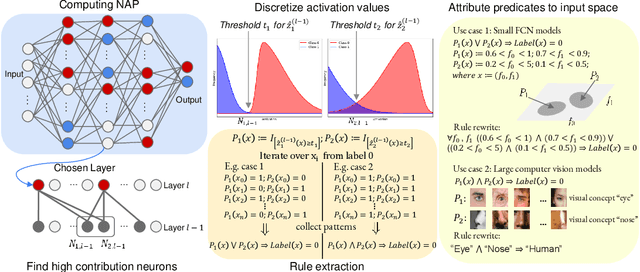



Abstract:As deep neural networks continue to excel across various domains, their black-box nature has raised concerns about transparency and trust. In particular, interpretability has become increasingly essential for applications that demand high safety and knowledge rigor, such as drug discovery, autonomous driving, and genomics. However, progress in understanding even the simplest deep neural networks - such as fully connected networks - has been limited, despite their role as foundational elements in state-of-the-art models like ResNet and Transformer. In this paper, we address this challenge by introducing NeuroLogic, a novel approach for decoding interpretable logic rules from neural networks. NeuroLogic leverages neural activation patterns to capture the model's critical decision-making processes, translating them into logical rules represented by hidden predicates. Thanks to its flexible design in the grounding phase, NeuroLogic can be adapted to a wide range of neural networks. For simple fully connected neural networks, hidden predicates can be grounded in certain split patterns of original input features to derive decision-tree-like rules. For large, complex vision neural networks, NeuroLogic grounds hidden predicates into high-level visual concepts that are understandable to humans. Our empirical study demonstrates that NeuroLogic can extract global and interpretable rules from state-of-the-art models such as ResNet, a task at which existing work struggles. We believe NeuroLogic can help pave the way for understanding the black-box nature of neural networks.
 Add to Chrome
Add to Chrome Add to Firefox
Add to Firefox Add to Edge
Add to Edge